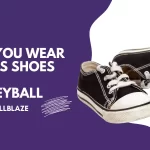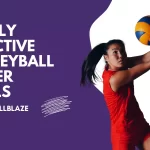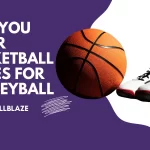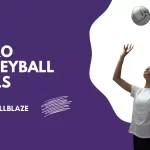Volleyball’s difficulty level is largely determined by the position you play, whether we like to admit it or not.
It is possible to fill some roles with a great deal more responsibility and technical prowess, while others require a lot less.
In order to get a better understanding of the roles in volleyball, I ranked the 5 primary positions from easiest to hardest.
This is a great place to start if you are having trouble deciding which position is best for you!
How Do You Define Difficulty in a Position?
As far as the difficulty of a position is concerned, there are two main factors to consider.
Expertise in technical skills
All players on the court should know how to set, but only the setter will be able to master this skill to a point above everyone else.
The ability to set is one thing, but the ability to set extremely well and consistently is another.
It is also a very difficult skill to master in volleyball as a middle blocker to time a B-quick attack.
Volleyball has many skills like this that are difficult to learn, but much harder to master.
Responsibilities and intangibles
Second, there are what I call the intangibles that make volleyball positions challenging.
Setting the ball is only one important part of what a setter does, but they are also responsible for coordinating an entire offense and ensuring the attackers know exactly what they’re doing at all times.
Against the particular defensive configuration they’re facing, they must also make sure these offensive plays make sense.
Their approach must be continually adjusted throughout every point and constant communication is required.
There are times when outside hitters must apply the technique of spiking not only three times in a row but also have it blocked with the scores level at 23-23.
As a result, despite failing horribly three times in the previous point, they have a great responsibility to swing on the next ball with complete confidence.
The pressure is on!
Alternatively, liberos need to make really good passes and dig the balls as hard as they can.
The process is, for the most part, straightforward.
The easiest volleyball positions are listed first, followed by the hardest.
Hardest To Easiest Positions In Volleyball: Ranked By Professionals
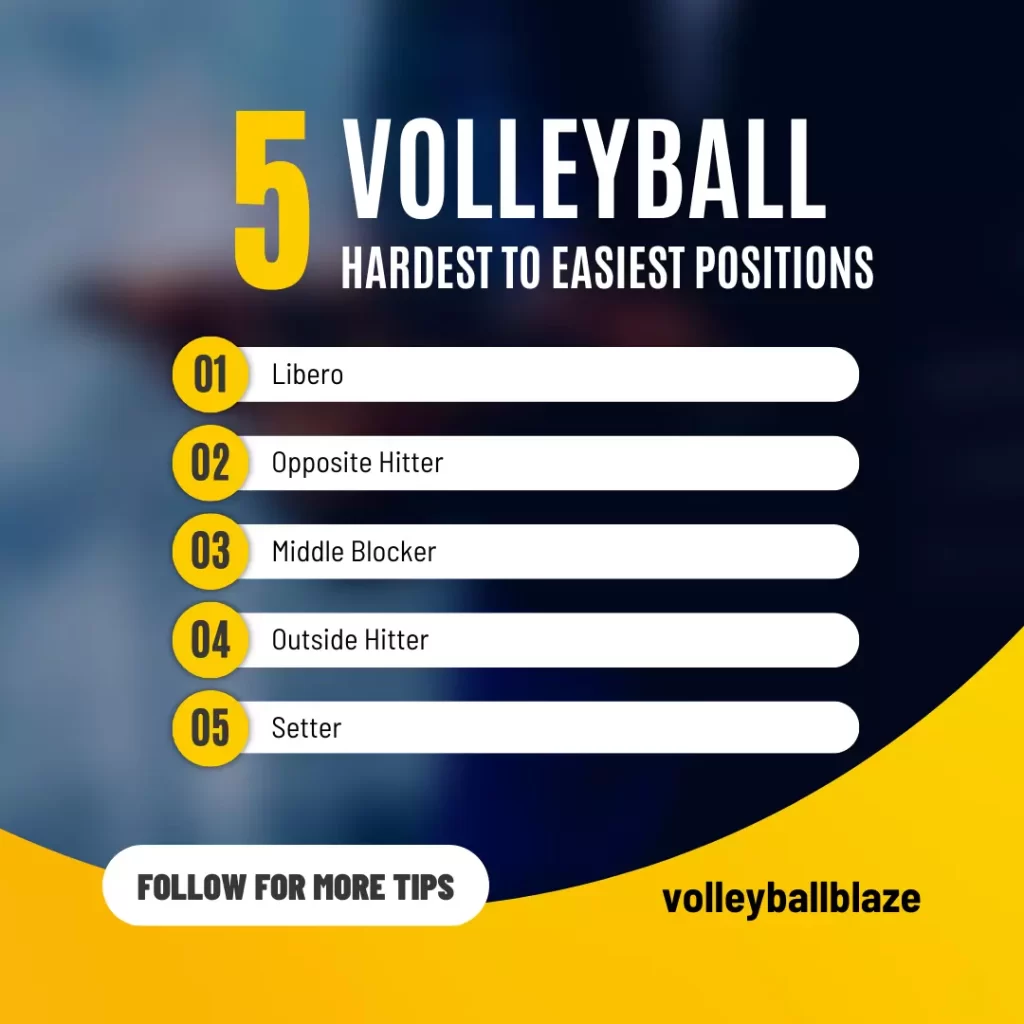
The following are the 5 hardest to easiest volleyball positions:
- Libero
- Opposite Hitter
- Middle Blocker
- Outside Hitter
- Setter
1. Libero: The Defensive Dynamo
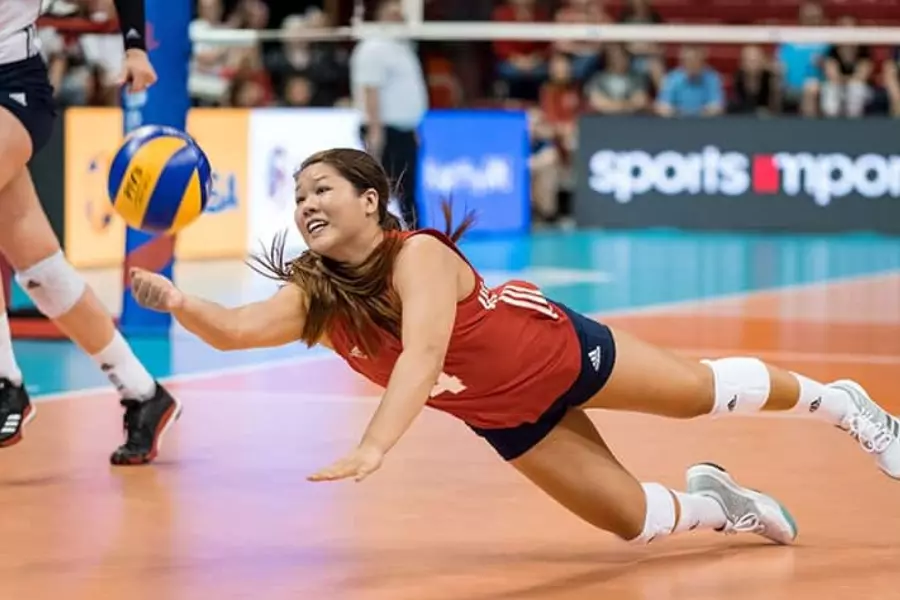
Libero is a very straightforward position in my opinion.
Although I’m far from a libero, I’d like to share my thoughts.
Liberos have a short list of tasks to perform in court.
They must be able to pass well in order to do their job. Digging the ball well is the other half of the equation.
In most cases, liberos do not serve the ball, so they simply have to improve their passing and defensive skills.
There is no doubt that digging is the hardest skill in volleyball, but a lot of that has to do with the fact that it’s almost impossible to dig many balls hit in your direction by an elite-level spiker.
It doesn’t matter how good your reaction time is if your blockers don’t do their jobs, you’re going to get hit with a volleyball if they don’t do their job.
My opinion is that liberos are a fairly one-dimensional position because they don’t have to spike or serve the ball.
While libero may seem like a difficult position, there are many counterarguments.
- Professional contracts for this position are difficult to obtain, and it is also the lowest-paid position.
- In this game, you’re tasked with defending spikes that are completely indefensible.
- There is no one who takes more volleyballs to the face than you.
This is true, but I find the role to be the easiest because of its unidimensionality.
Why is Libero Challenging?
Because of their limited offensive capabilities and high-pressure situations, the Libero position is demanding.
You can also read Libero Volleyball Drills
2. Opposite Hitter: The Versatile Attacker
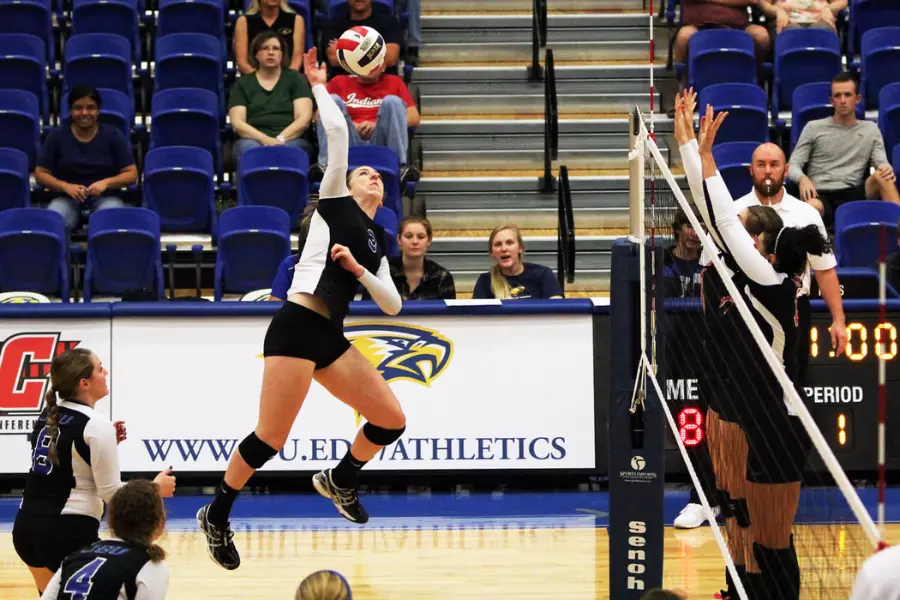
It’s fairly easy to play opposite hitter in volleyball (which sounds ridiculous to say out loud), mainly due to its simplicity.
You just need to stand at the net, be tall, and look pretty…
However, much talent and money go to volleyballers who are opposites.
What makes it easy?
In addition to serving, blocking, hitting, defending, and hitting from the backcourt, the opposite must also defend well.
Many of these players score the most points on their teams and are highly athletic and talented.
In many ways, opposites are like outside hitters, except they do not pass the ball.
My main reason for rating it fairly high is because it’s basically just an outside hitter with less cruisiness.
Additionally, I played as an undersized right-handed opposite at an international-level tournament, so I completely understand how challenging it can be!
The Challenges of Being an Opposite Hitter
In addition to being essential for scoring, Opposite Hitters also need to adapt to different defensive strategies and deal with tough blockers.
3. Middle Blocker: The Net Protector
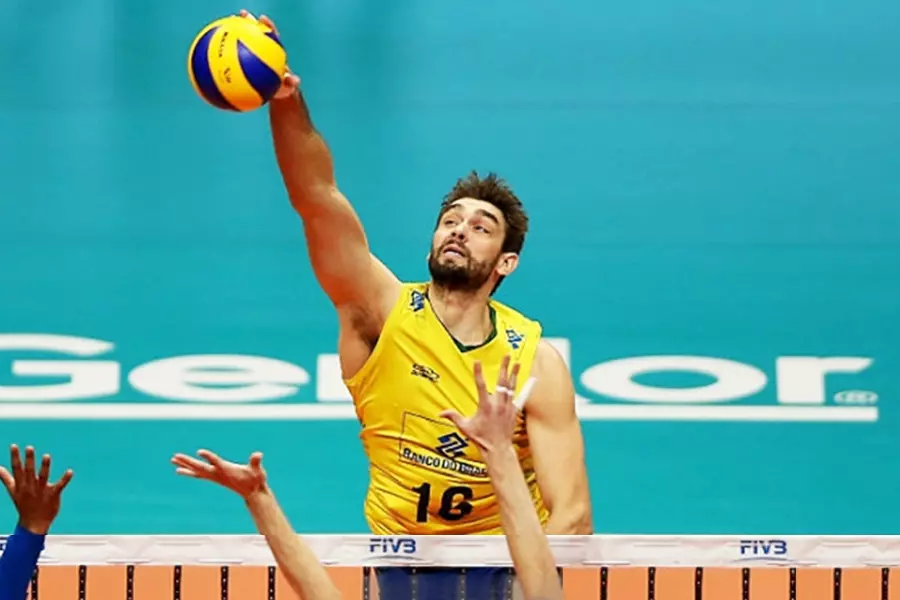
Having been a middle blocker myself, I might be biased, but I believe there are good reasons to have this position here.
Middle blockers are notorious for having a limited amount of time to react when blocking.
Speed of block reaction
Whether the ball is dumped over the net by the setter, or directed to the outside or right, the middle blocker needs to block every single set.
In high-level offenses, sets are run very quickly, forcing players to get to the sticks much faster than they can move.
You must react with lightning speed and perfect footwork to get into position to block the spiker as you watch the opposition pass the ball to the setter.
Since most of the time they only have to block one player standing right in front of them, outsiders and opposites don’t understand how difficult it is.
Timing is offensive
On offense, a middle blocker can also be challenging due to timing.
In comparison to other players on the court, middles run faster offenses. Even when the pass is perfect, B-quicks are difficult to time (as shown in the clip above).
The key to a successful offense is timing the pass perfectly and being prepared to hit from all sorts of awkward positions, no matter where the pass lands.
The middles are also responsible for serving the ball.
One of the most difficult and underappreciated positions on the floor is the middle blocker due to the technical difficulty of timing.
The Demands on Middle Blockers
This position requires quick decision-making and accurate timing, making it both challenging and rewarding.
4. Outside Hitter: The All-Rounder
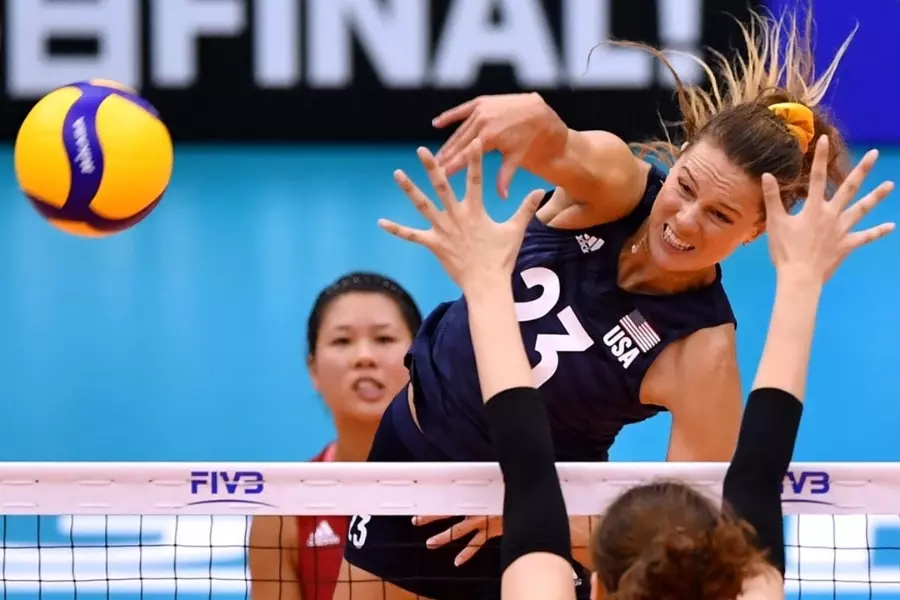
There are several reasons why outside hitters are the most challenging position on the offensive side of volleyball.
To do this properly, you need a wide variety of skills, which makes it an extremely multidimensional role.
Serve, Block, Spike, Dig, Pass
In contrast to middles or liberos, outside hitters usually play all the way around the court.
Their passing must be excellent, and they must be ready to transition immediately to offense.
The outside position generally receives more balls than any other position, making them highly technical at spiking.
It goes without saying that they must be able to block, dig, as well as hit back-row balls, and serve.
They never get a break!
As a result of the responsibilities associated with these positions, outsiders are often seen as go-to attackers in a variety of situations.
Communication is also more important to them than it is to most other court positions.
It’s virtually impossible for any human to master so many difficult skills in one lifetime, so it’s rare to find an outside hitter without some weaknesses!
The Challenges of Being an Outside Hitter
They are required to adapt to various game situations under pressure and perform well under pressure.
5. Setter: The Court Maestro
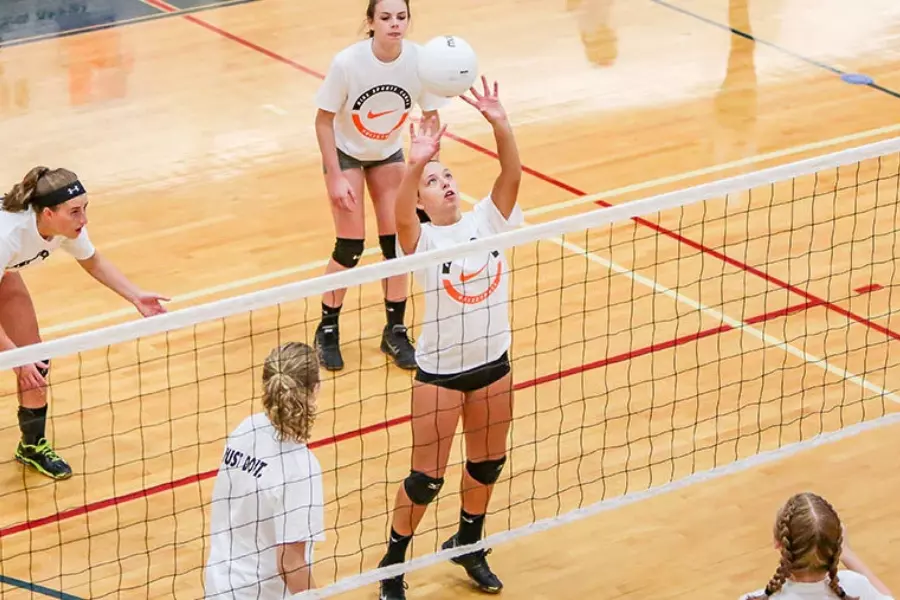
In volleyball, there is little debate about which position is the most difficult.
Setter is widely acknowledged to be among the most difficult roles in sports.
Every player on the court has some responsibility, but setters have a lot more responsibility than anyone else.
In the back court and front court, they’re like the glue that holds everything together.
It is even worse if the setter is bad than if the spiker is good.
The Setting Skill Is Difficult
Getting the physical act of setting a volleyball right requires a lot more practice and repetition than other skills and is considered an extremely difficult skill to master. You can practice with volleyball rebounders.
The setter must also be able to block in the front court.
Servability is also important.
Setters must carry their teams
Sometimes, setters have to chase down errant passes while still delivering something a hitter can use.
It is often the setter who takes the blame when something goes wrong.
In order to coordinate their team’s offense, setters must stay in constant communication with each attacking player.
Regardless of whether they are team captains or not, they should act as if they are.
You should shake your setter’s hand instead of complaining next time he doesn’t set the perfect ball!
The Unique Challenges of Setters
In volleyball, setters orchestrate the offense and deliver precise balls to the hitters.
You may enjoy reading Volleyball Setter Workouts
FAQs
What makes the middle blocker position so challenging?
Middle blockers have a challenging position because their blocking and attacking skills require split-second timing. At the net, it’s a high-pressure role.
Which volleyball position is the easiest?
The easiest volleyball position is the libero. Unlike attacking players, liberos do not jump, so they do not need to be particularly strong or tall. In some cases, it involves setting skills and in others, defensive skills.
Why is the setter often compared to a quarterback in volleyball?
Unlike quarterbacks, setters orchestrate the team’s offense by assisting their teammates in executing successful attacks.
What sets the libero apart from other defensive specialists?
There is a unique characteristic of the libero, which is that they are not allowed to attack the ball above the net. For ball control, they primarily focus on digging, passing, and serving.
How important are outside hitters in volleyball?
Both offensively and defensively, outside hitters contribute to the versatility of the team.
Are there any recommended drills to improve skills for these positions?
Players can improve their skills and excel in their roles through various drills and exercises tailored to their position.
What volleyball position gets injured the most?
Injuries are most likely to occur at outside hitter, middle blocker, libero, setter, and opposite. Overuse injuries and injuries caused by contact with another person account for the majority of injuries.
What is the hardest position in girls’ volleyball?
The perception of the hardest position in girls’ volleyball can vary, but one position that is often considered challenging is the setter position.
Conclusion
There is a wide range of volleyball positions, each with its own challenges and demands. Understand the hierarchy of positions on the court, from the demanding Libero to the versatile Setter.
It is easiest for beginners to play libero since you don’t need to be tall to play it. Consider becoming a middle blocker if you are tall. Outside hitters or opposite hitters are good ideas, but they must be extremely athletic. Having to deal with almost everything on the court is the hardest job for a setter. Moreover, you can read our guide on Volleyball Setter Drills.
In order to train at home with volleyball, training equipment is recommended.

